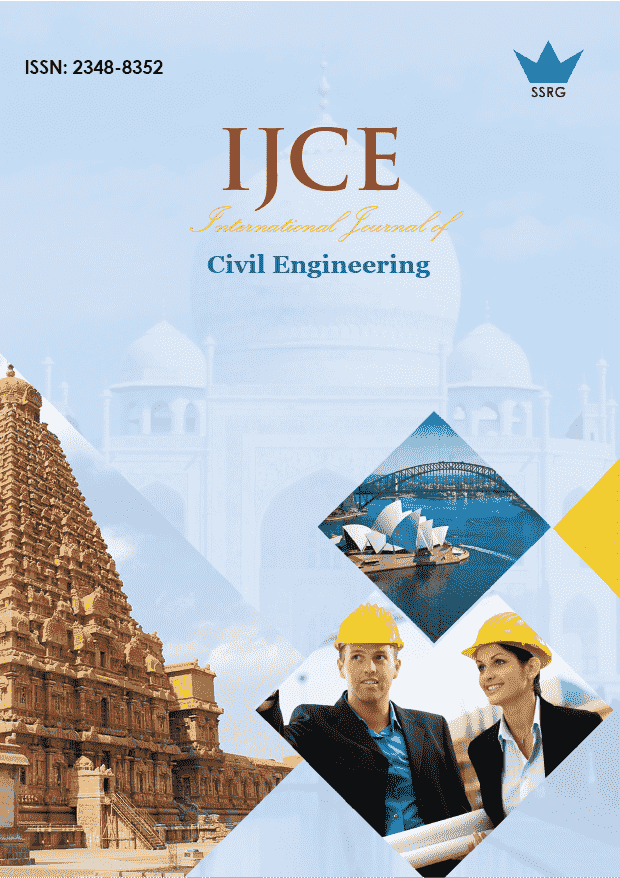Underground Pipeline Leakage Risk Evaluation in Ajdabiya City, Libya

| International Journal of Civil Engineering |
| © 2022 by SSRG - IJCE Journal |
| Volume 9 Issue 1 |
| Year of Publication : 2022 |
| Authors : Saleh Emhanna, Hassan Dauas, Almasri Fadil, Sulayman Aqdourah |
How to Cite?
Saleh Emhanna, Hassan Dauas, Almasri Fadil, Sulayman Aqdourah, "Underground Pipeline Leakage Risk Evaluation in Ajdabiya City, Libya," SSRG International Journal of Civil Engineering, vol. 9, no. 1, pp. 7-14, 2022. Crossref, https://doi.org/10.14445/23488352/IJCE-V9I1P102
Abstract:
Leak detection in transmission pipelines is crucially important for safe operation. Delay in detecting leaks leads to loss of property, roads and infrastructures. This research work is aimed to detect the leaks and evaluate their causes and effects. The results show that the leakages caused by; networks are small size pipes with high pressure, corrosion, damaged pipe joints, the rising water level in the city and tree roots. The ground subsidence and sinkholes spread in several streets in the city are the most common way to identify the leaks in the water and sewer networks. Pipeline leakage has both economic and environmental effects where the leaks cause many problems such as; health hazards a result of mixed groundwater with leaked wastewater. Loss of drinking water, soil erosion and ground subsidence. Also, leakages involve a significant economic loss reached 2 million Libyan dinars in the last 10 years. Most water and wastewater pipes are buried underground, making them difficult to find the location of leaks. So, using smart technologies such as; ground-penetrating radar, Acoustic systems, Sensor hoses, Fiber Optic Cable.. etc., are important to detect the leakages in the early stage.
Keywords:
Leakage, Water and Sewer System, Pollution, Ground Subsidence.
References:
[1] B. Rajani, and Y. Kleiner., “Non-Destructive Inspection Techniques to Determine Structural Distress Indicators in Water Mains,” Nrc Publications Archive (NPArC), pp. 1-20, 2004.
[2] Shing-Yu Chen, et al., “Underground Pipeline Leakage Risk Assessment in an Urban City,” International Journal of Environmental Research and Public Health, vol. 17. No. 11, pp. 3929, 2020. htps://doi.org/10.3390/IJERPH17113929.
[3] T. Karoui, et al., “Experimental Study of Ground Subsidence Mechanism Caused By Sewer Pipe Cracks,” Applied Science, vol. 8, no. 5, pp. 679, 2018. Crossref, https://doi.org/10.3390/app8050679
[4] Hassan Saghi, and Abbas Ansari Aval “Effective Factors in Causing Leakage in Water Supply Systems and Urban Water Distribution Networks,” American Journal of Civil Engineering. Special Issue: Research and Practices of Civil Engineering in Developing Countries, vol. 3, no. 2-2, pp. 60-63, 2015. Crossref, https://doi:10.11648/J.AJCE.S.2015030202.222
[5] Kang Jing ZouZhi-Hong, “Time Prediction Model for Pipeline Leakage Based on Grey Relational Analysis,” Physics Procedia, vol. 25, pp. 2019-2024, 2012. Crossref, https://doi.org/10.1016/j.phpro.2012.03.344
[6] Weifeng Li, “Development of a System for Detection, Early Warning, and Control of Pipeline Leakage in Drinking Water Distribution: A Case Study,” Journal of Environmental Science, vol. 23, no. 11, pp. 1816-1822, 2011. Crossref, https://doi.org/10.1016/S1001- 0742(10)60577-3
[7] R. Perez, et al., “Methodology for Leakage Isolation Using Pressure Sensitivity Analysis in Water Distribution Networks,” Control Engineering Practice, vol. 19, no. 10, pp. 1157-1167, 2011. Crossref, https://doi.org/10.1016/j.conengprac.2011.06.004
[8] Antony Marunga, Zvikomborero Hoko, Evans Kaseke, “Pressure Management as a Leakage Reduction and Water Demand Management Tool: the Case of the City of Mutare, Zimbabwe,” Physics and Chemistry of the Earth, vol. 31, no. 15-16, pp. 763-770, 2006. Crossref, https://doi.org/10.1016/j.pce.2006.08.032
[9] Matteo Nicolini, Carlo Giacomello, and Kalyanmoy Deb, “Calibration and Optimal Leakage Management for a Real Water Distribution Network,” Journal of Water Resources Planning and Management, vol. 137, no. 1, pp. 134-142, 2011. Crossref, https://doi.org/10.1061/(ASCE)WR.1943-5452.0000087
[10] L. Berardi, O. Giustolisi, F. Primativo, “Exploiting Multi-Objective Strategies for Optimal Rehabilitation Planning,” Proceedings of Computer and Control in Water Industry (CCWI) - Water Management Challenge Sin Global Changes-Ulaniki, Taylor and Francis Group, London, pp. 23-30, 2007.
[11] S. Araujo, H. Ramos, and T. Coelho, “Pressure Control for Leakage Minimization in Water Distribution Systems Management,” Water Resources Management, vol. 20, no. 1, pp. 133-149, 2006. Crossref, http://dx.doi.org/10.1007/s11269-006-4635-3
[12] M., Tabesh, and K. Karim, Determination of the Leak Detection and the Renewal Time of Urban Water by Analyzing the Accident Data, vol. 5 , pp. 597 – 610, 2006.
[13] https://www.Exponent.com
[14] https://www.Mswmag.com/
[15] Saleh Emhanna, et al., “Physical and Environmental Effects of Groundwater Table Rising in Ajdabiya Town, Northeast Libya,” Iraqi Geological Journal, vol.53, no. 2f, pp. 36-48, 2020. Crossref, https://doi:10.46717/IGJ.53.2F.3MS-2020-12-26.
[16] Saleh Emhanna, Najeeb Ben Musa, and Mostafa F. Mostafa, “Causes and Impacts of Rising Water Table in Ajdabiya City, Ne Libya,” International Journal of Environment & Water, vol. 10, no. 2, pp. 127-140, 2021.
[17] Osama Rahil Shaltami, et al., “Assessment of Drinking Water Quality and Sanitation in Ajdabiya City, Ne Libya,” Iraqi Geological Journal, vol.53, no. 1b, 2020.
[18] S. Al Kassah, et al., “Hydrochemical Study of Some Groundwater Wells in Ajdabiya, Libya,” The Fourth Scientific Conference of Environment and Sustainable Development in the Arid and Semi-Arid Regions (ICESD), pp. 839- 856, 2018.
[19] S. Al Teera, and F. Ashweshin, “Environmental Impacts of the Wastewater Treatment Plant in Ajdabiya According to Sustainability Approaches,” The Fourth Scientific Conference of Environment and Sustainable Development in the Arid and Semi-Arid Regions (ICESD), pp. 386- 406, 2018.
[20] Al Fakhiry, and A. Fayez, “The Environmental Effects of the Ajdabiya Sewage Station and Sewage Treatment,” Environmental Journal, pp. 22, 2004.
[21] Mingliang Gao et al., “Regional Land Subsidence Analysis in Eastern Beijing Plain by Insar Time Series and Wavelet Transforms,” Remote Sensing, vol. 10, no. 3, pp. 365, 2018. Crossref, https://doi.org/10.3390/rs10030365
[22] Prof. Shivaji H. Kalyankar et al., “Non_Destructive Testing,” SSRG International Journal of Civil Engineering, vol. 7, no. 4, pp. 19- 21, Crossref, 2020. https://doi:10.14445/23488352/IJCE-V7I4P104.
[23] “The General Company for Water and Sanitation,” 2022.

 10.14445/23488352/IJCE-V9I1P102
10.14445/23488352/IJCE-V9I1P102